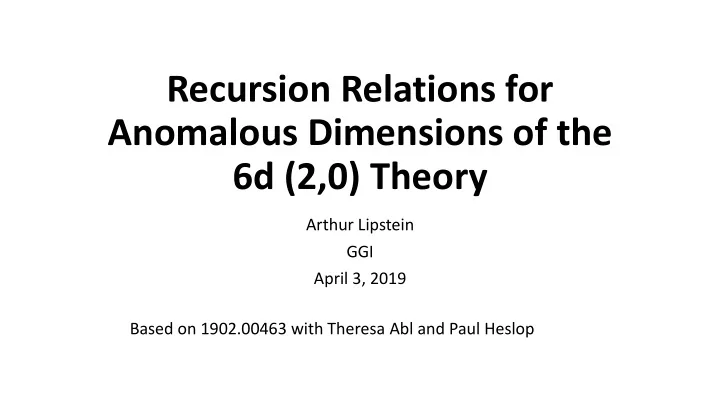

Recursion Relations for Anomalous Dimensions of the 6d (2,0) Theory Arthur Lipstein GGI April 3, 2019 Based on 1902.00463 with Theresa Abl and Paul Heslop
AdS/CFT Worldvolume Gravity Dual • D3 branes IIB string theory on AdS 5 x S 5 • M2 branes M-theory on AdS 4 x S 7 • M5 branes M-theory on AdS 7 x S 4
M5-branes • Abelian theory: 5 scalars, 8 fermions, self-dual 2-form (Howe,Sierra,Townsend) • Non-abelian theory strongly coupled, so what can we say about it? • OSp(8|4) symmetry • When N ∞, described by 11d supergravity in AdS 7 x S 4 • Central charge c is O(N 3 ) (Henningson,Skenderis) • Goal: Go beyond the supergravity approximation
Stress Tensor Correlators • The stress tensor belongs to a ½ BPS multiplet whose lowest component is a dimension 4 scalar in the symmetric traceless representation ( 14 ) of the R- symmetry group SO(5) • In the large-N limit, 4-point correlators of stress tensor multiplets can be computed using Witten diagrams for 11d supergravity in AdS 7 x S 4 . • Strategy: Use superconformal and crossing symmetry to deduce 1/N corrections to 4-point correlators, which correspond to higher derivative corrections to 11d supergravity arising from M-theory.
4-Point Function • Superconformal symmetry fixes the 4-point function in terms of a pre-potential where , , Arutyunov,Sokatchev/Heslop • Crossing symmetry:
CPW Expansion • Decompose 4-point function as follows: • These functions can be written as a sum over operators appearing in TT OPE • A, g, G encode identity, protected, and unprotected operators, respectively: where unprotected ops have scaling dimension
• In more detail, where superconformal blocks can be written in terms of hypergeometrics ((Dolan,Osborne/Heslop/Beem,Lemos,Rastelli,van Rees • Expand OPE data in 1/c: • Crossing:
Supergravity Prediction • Free disconnected contribution: • Decomposing into A, g, G and performing CPW expansion of G gives
• Dynamical contribution: (Arutyunov,Sokatchev) where the D functions arise from AdS integrals: • Performing CPW decomposition gives anomalous dimensions which scale like n 5 • The CPW coefficients satisfy (Heslop,Lipstein)
Corrections to Supergravity • Heemskerk, Penedones, Polchinski, Sully considered 4-point functions in a generic 2d or 4d CFT with a large-N expansion and solved the crossing equations to leading order in 1/c by truncating the CPW expansion in spin. • They showed that the solutions are in 1 to 1 correspondence with local quartic interactions for a massive scalar field in AdS, which can be thought of as a toy model for the low-energy effective theory of the gravitational dual. • The number of derivatives in the bulk interaction is related to the large-twist behaviour of the anomalous dimensions.
Examples spin interactions anomalous dim. n const 0 n const+4 , n const+6 2 n const+8 , n const+10 , n const+12 4
Spin-0 • Spin-0 solution: (Helsop,Lipstein) • Anomalous dimensions: • Scales like n 11 in the large-n limit.
Effective Action • At large twist, • This suggests that term in the bulk effective action corresponding to the spin-0 solution has six more derivatives than the supergravity Lagrangian, and is therefore of the form (Riemann) 4 . • This is the M-theoretic analogue of ( α’) 3 corrections in string theory and was previously deduced in flat space by uplifting string amplitudes (Green,Vanhove) • Similarly, we obtained solutions up to 20 derivatives (truncated spin 4) by guessing crossing symmetric functions and checking their CPW expansions.
Recursion Relations • Recall crossing eq: • Conformal blocks have schematic structure where • gives a term with so isolate by taking
• In order for crossing equations to be consistent, the coming from must be accompanied by a . Such terms arise from where • Collecting terms proportional to then gives a refined crossing eq:
• To get numerical recursion relations, multiply by and perform contour integrals around • Use orthogonality of hypergeometrics and define
• Master equation: where • Recursion relations follow from choosing (p,q) appropriately and solutions are labelled by spin truncation L.
Solutions • Let’s first consider L=0. Choosing q=0 gives the following recursion relation in terms of p, which is readily solved on a computer to give where is an unfixed parameter. • For spin-L truncation, the solution will depend on (L+2)(L+8)/4 free parameters, in agreement with holographic arguments based on counting bulk vertices
Conclusions • Found recursion relations for anomalous dimensions of double-trace operators in CPW expansion of 4-point stress tensor correlators in M5-brane theory. • Solutions encode the low-energy effective action for M-theory on AdS 7 x S 4 , at least up to four-point interactions with unfixed coefficients. • Next : Fix coefficients in M-theory effective action using chiral algebra conjecture Beem,Rastelli,van Rees/Chester,Perlmutter • Explore loop expansion using methods developed for N=4 SYM by Aprile,Drummond,Heslop,Paul/Alday,Bissi
Recommend
More recommend